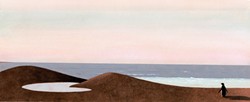
- IMAGE BY HELEN K. DAVIE
- THE LAST PENGUIN : By Helen K. Davie
For a juried show, “Narrative Animal Imagery,” running Oct. 8 through Nov. 12, the museum turned to a company called OnCell, which provides organizations the means of creating their own cell phone tours.
The theme for the exhibit came from museum Assistant Director Muara Johnston who liked “the idea of using animals in fables to tell a greater story.” And in keeping with the goal of expanding the museum’s reach and presence, they issued a national call for submissions and tapped Greg Kucera, proprietor of the Greg Kucera Gallery in Seattle, to serve as juror.
The submissions range from an owl called Hedwig (undoubtedly inspired by Harry Potter’s snowy white friend), storybook illustrations featuring a mouse holding a doll, a whippet painted as a halo-clad saint, and a photograph of a fire hydrant with animal features sketched by a whimsical graffiti artist. They’re ominous, cute, mystical, unexpected, and fluffy. But getting there took some work.
“I think it’s fair to say that a lot of the work that was submitted fell into categories of cuteness or whimsy,” Kucera said, explaining his dilemma. “We want to think that contemporary art deals with additional issues—let’s say political statements or something that doesn’t appeal to the lowest common denominator to make its point. In this case, a lot of the submissions were too cute, too greeting card like. There was no great depth to a majority of the submissions.”
Kucera cited the title as a possible stumbling block. And, more specifically, the word “narrative,” which might have sent imaginations tripping down the storybook path. To round out its numbers, the museum contacted local artists and invited them to submit work.
Among the local artists whose work will be featured is Helen K. Davie, a member of the museum’s Central Coast Printmakers; Oil, Pastel, and Acrylic Painters Group; and Central Coast Watercolor Society. She’s also a resident artist at Studios on the Park in Paso Robles. With a background as a children’s book illustrator, it wouldn’t have been difficult for Davie to tap into the cute, whimsical aesthetic so many other artists embraced. Instead, her pieces, Raven and The Last Penguin, have a contemplative edge.

- PHOTO BY ANNA-MARIA VAG
- THE GUARDIAN : By Anna-Mária Vág
In The Last Penguin, Davie drew on scientific dialogue about global warming to create a portrait of a lone penguin looking out to sea. A 1963 nature novel by Allan Eckert, called The Great Auk, also influenced her work.
“That book had a very profound effect on me,” she explained. “It’s written scientifically, but it’s very moving. I realized that animals don’t have a way to communicate with us that we understand, so we have to be their voices.”
Davie is a self-confessed animal lover. She prefers their company, she explained, because their needs and motivations are simpler, more direct. And giving voice to their stories isn’t necessarily always about benefiting the animal. Sometimes animals have a lot to say about humans, as well.
“It’s not that we’re putting human attributes on animals,” she said. “We’re unmasking our animal attributes as humans.”
For Anna-Mária Vág, a photographer from Seattle, animals are generally secondary to buildings. Vág and her husband moved to Seattle from the Jersey Shore a mere year ago, and they like to set off on walking adventures to explore different neighborhoods. On one such jaunt, she spotted a teal fire hydrant with a face.
“It was a really interesting cross-over because it still has so much of what I’m looking for, trying to elicit character from a building,” she explained.
The color was a serendipitous bonus; teal is one of Vág’s favorites, suggestive of a kind of nostalgia that frequently appears in her work.
The face, most likely sketched onto the fire hydrant with a Sharpie, is not typical graffiti. Though there are no guarantees, the photographer considers it unlikely that a passerby would call in a complaint about the drawing. But this uncertainty is common throughout her work. Many of the buildings she happens upon are, unbeknownst to her, condemned or slated for renovation.
- WALK LIKE A PENGUIN: “Narrative Animal Imagery” is on exhibit at the SLO Museum of Art Oct. 8 through Nov. 12. For more information, visit sloartcenter.org. The museum is open 11 a.m. to 5 p.m. every day except Tuesday.
The title, The Guardian, came to her just before she submitted the photograph for the exhibit, clarifying the viewer’s immediate impression of the piece. Not quite watchdog or sentinel, the hydrant, trimmed with rust and glaring at some unseen threat or street scene, certainly evokes the attitude of a guard dog. It is, of course, a fire hydrant—inanimate—which could be the point of the photograph. Or a completely irrelevant detail that merely distracts from the greater message. You decide.
Managing Editor Ashley Schwellenbach is more of a fire hydrant person than a raven person. Send comments to [email protected].
Comments